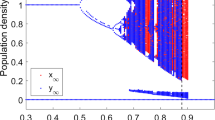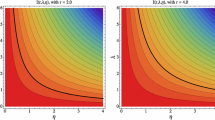Abstract
We provide sharp conditions distinguishing persistence and extinction for a class of discrete-time dynamical systems on the positive cone of an ordered Banach space generated by a map which is the sum of a positive linear contraction A and a nonlinear perturbation G that is compact and differentiable at zero in the direction of the cone. Such maps arise as year-to-year projections of population age, stage, or size-structure distributions in population biology where typically A has to do with survival and individual development and G captures the effects of reproduction. The threshold distinguishing persistence and extinction is the principal eigenvalue of \(({\mathbb {I}}-A)^{-1}G'(0)\) provided by the Krein-Rutman Theorem, and persistence is described in terms of associated eigenfunctionals. Our results significantly extend earlier persistence results of the last two authors which required more restrictive conditions on G. They are illustrated by application of the results to a plant model with a seed bank.
Similar content being viewed by others
References
Bacaër N (2009) Periodic matrix population models: growth rate, basic reproduction number, and entropy. Bull Math Biol 71:1781–1792
Bacaër N, Ait EH (2012) Dads, On the biological interpretation of a definition for the parameter R0 in periodic population models. J Math Biol 65:601–621
Bonsall FF (1958) Linear operators in complete positive cones. Proc Lond Math Soc 8:53–75
Cushing JM (2011) On the relationship between \(r\) and \(R_0\) and its role in the bifurcation of stable equilibria of Darwinian matrix models. J Biol Dyn 5:277–297
Cushing JM, Ackleh AS (2012) A net reproductive number for periodic matrix models. J Biol Dyn 6:166–188
Cushing JM, Zhou Y (1994) The net reproductive value and stability in matrix population models. Nat Res Mod 8:297–333
Deimling KD (1985) Nonlinear functional analysis. Springer, Berlin Heidelberg
Diekmann O, Getto P, Gyllenberg M (2007) Stability and bifurcation analysis of Volterra functional equations in the light of suns and stars. SIAM J Math Anal 39:1023–1069
Diekmann O, Gyllenberg M, Huang H, Kirkilionis M, Metz JAJ, Thieme HR (2001) On the formulation and analysis of general deterministic structured population models. II. Nonlinear theory. J Math Biol 43:157–189
Diekmann O, Gyllenberg M, Metz JAJ (2003) Steady-state analysis of structured population models. Theor Pop Biol 63:309–338
Diekmann O, Gyllenberg M, Metz JAJ, Thieme HR (1998) On the formulation and analysis of general deterministic structured population models. I. Linear theory. J Math Biol 36:349–388
Diekmann O, Gyllenberg M, Metz JAJ, Nakaoka S, de Roos AM (2010) Daphnia revisited: local stability and bifurcation theory for physiologically structured population models explained by way of an example. J Math Biol 61:277–318
Eager EA, Rebarber R, Tenhumberg B (2014) Global asymptotical stability of plant-seed bank models. J Math Biol 69:1–13
Gyllenberg M, Lant T, Thieme HR (2006) Perturbing evolutionary systems on dual spaces by cumulative outputs. Diff Integr Eqn 19:401–436
Gyllenberg M, Metz JAJ (2001) On fitness in structured metapopulations. J Math Biol 43:545–560
Jin W (2014) Persistence of discrete dynamical systems in infinite dimensional state spaces. Dissertation, Arizona State University
Jin W, Thieme HR (2015) An extinction/persistence threshold for sexually reproducing populations: the cone spectral radius (under review)
Kato T (1976) Perturbation theory for linear operators. Springer, Berlin Heidelberg
Krasnosel’skij MA, Lifshits JA, Sobolev AV (1989) Positive linear systems: the method of positive operators. Heldermann Verlag, Berlin
Krause U (2015) Positive dynamical systems in discrete time. Theory, models and applications. De Gruyter, Berlin
Krein MG (1939) Sur les opérations linéaires transformant un certain ensemble conique en lui-même. CR (Doklady) Acad Sci URSS (NS) 23:749–752
Krein MG, Rutman MA (1948) Linear operators leaving invariant a cone in a Banach space (Russian). Uspehi Mat Nauk (NS) 3:3–95, Am Math Soc Transl (1950)
Lemmens B, Nussbaum RD (2012) Nonlinear Perron-Frobenius theory. Cambridge University Press, Cambridge
Lemmens B, Nussbaum RD (2013) Continuity of the cone spectral radius. Proc Am Math Soc 141:2741–2754
Mallet-Paret J, Nussbaum RD (2010) Generalizing the Krein-Rutman theorem, measures of noncompactness and the fixed point index. J Fixed Point Theory Appl 7:103–143
Nussbaum RD (1981) Eigenvectors of nonlinear positive operators and the linear Krein-Rutman theorem. In: Fadell E, Fournier G (eds) Fixed Point Theory. Springer, New York, pp 309–331
Nussbaum RD (1998) Eigenvectors of order-preserving linear operators. J Lond Math Soc 2:480–496
Rebarber R, Tenhumberg B, Townley B (2012) Global asymptotic stability of density dependent integral population projection models. Theor Popul Biol 81:81–87
Schaefer HH (1966) Topological vector spaces. Macmillan, New York
Smith HL, Thieme HR (2011) Dynamical systems and population persistence. AMS, Providence
Smith HL, Thieme HR (2013) Persistence and global stability for a class of discrete time structured population models. Disc Cont Dyn Syst 33:4627–4646
Smoller J (1983) Shock waves and reaction-diffusion equations. Springer, New York
Thieme HR (2009) Spectral bound and reproduction number for infinite dimensional population structure and time-heterogeneity. SIAM J Appl Math 70:188–211
Thieme HR (2013) Eigenvectors and eigenfunctionals of homogeneous order-preserving maps. arXiv:1302.3905v1 [math.FA]
Thieme HR (2014) Eigenfunctionals of homogeneous order-preserving maps with applications to sexually reproducing populations (under review)
Acknowledgments
The authors thank two anonymous referees and the handling editor Odo Diekmann for their very helpful comments.
Author information
Authors and Affiliations
Corresponding author
Additional information
W. Jin partially supported by NSF Grant DMS-0715451; H. L. Smith partially supported by NSF Grant DMS-0918440.
Rights and permissions
About this article
Cite this article
Jin, W., Smith, H.L. & Thieme, H.R. Persistence versus extinction for a class of discrete-time structured population models. J. Math. Biol. 72, 821–850 (2016). https://doi.org/10.1007/s00285-015-0898-8
Received:
Revised:
Published:
Issue Date:
DOI: https://doi.org/10.1007/s00285-015-0898-8
Keywords
- Basic reproduction number
- Net reproductive number
- Basic turnover number
- Krein-Rutman theorem
- Plant population
- Seed bank
- Persistence threshold
- Eigenfunctional
- Stability




